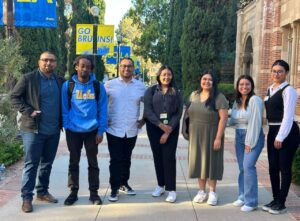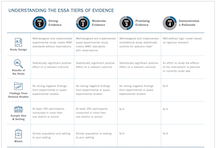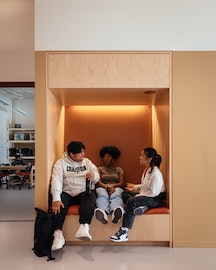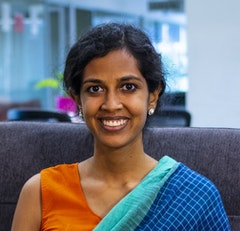
NEW YORK — Loyal Harmoni Harris travels every day to Bronx Regional High School, where she learns emotional, motor and language skills. Loyal is a bit younger than the other students at the high school — in fact, she’s only 2 years old.
That’s because Loyal is part of a unique New York City program called LYFE — Living for the Young Family Through Education. LYFE offers free early childhood education to student parents attending city public schools. Loyal’s mother, Honesti Melendez, is 16 and attends high school in the same building where her daughter learns.
LYFE isn’t new. It’s more than 30 years old and serves more than 300 early childhood students at 31 centers across the city. But since its inception as a child care initiative for young mothers, LYFE has grown into a three-generation educational program that officials and experts say can help not just student parents, but their children and families as well.
“We became more than a babysitter,” says Mignon Callender, a former LYFE student parent and current LYFE teacher. “We know that we are teaching more than the children in this program.”
Some of the benefits of such a program to student parents are obvious. Having free child care makes it easier for them to remain in school and continue on a path to graduation. LYFE centers have expanded hours so that student parents can take part in extracurricular activities or hold jobs.
But LYFE offers other services as well. Every student parent is connected with a social worker who helps them plot a path forward and think about their futures. Social workers also help other family members find jobs and work through other issues. Experienced educators help students learn parenting skills. Special workshops and outings get students acquainted with the idea of college and other postgraduate opportunities.
And leaders say the program offers a judgment-free refuge for students who often face stigma.
“One thing we don’t do is come in with any preconceived notions of why families are here,” says James Williams, principal of the LYFE program. “They’ve been judged by their doctor. They’ve been judged by the bus driver, their friends, their parents. They don’t get judged by us.”
Melendez, the mother of Loyal, says she sometimes feels that judgment from students her age, but that the LYFE program has given her other priorities to focus on. Melendez didn’t know about the program when she gave birth and often missed school to take care of her baby. Today, her hope is not only to graduate, but to attend college and become a lawyer.
“I love being here. I love their support, not only for the babies, but the parents too,” Melendez says. “I don’t think I would be in high school, to be honest with you, if I didn’t have the LYFE center.”
For young children, the center is more than just a safe environment to play. The program aims to offer high-quality education, even to infants, with no income restrictions. (Programs like Early Head Start limit eligibility by income and other factors, while New York’s citywide pre-K serves 4-year-olds.) Classrooms use a teacher-directed and project-based curriculum called The Creative Curriculum, from the company Teaching Strategies, to outline objectives and design teaching plans.
The rooms at Bronx Regional are colorful and are well-stocked with learning tools like water and sand tables and interactive areas for play or getting acquainted with books. Children learn how to put ornaments on a tree, or learn words about nature and camping.
“The work with our children across this school system begins with our youngest learners,” says Kara Ahmed, current Department of Education deputy chancellor of early childhood education for the city and former principal of LYFE. “We have this incredible opportunity in LYFE to begin as young as six weeks.”
Teenage mothers and their children often face negative outcomes as they age. But that is not largely due to how old a parent is when they have a child, and rather is tied to the fact that teens who have children are often in especially disadvantaged social and economic positions, says Stefanie Mollborn, a professor at Stockholm University and affiliate at University of Colorado Boulder who researches youth health and development. About 30 percent of the student parents in LYFE are in temporary housing, for example. And about half of the program’s families do not speak English as their primary language.
Though teen parents begin to catch up with their peers in the first few years of their child’s life, the children themselves tend to begin to fall behind in their academic, cognitive, behavioral and health outcomes, Mollborn says.
“By the time these kids start kindergarten, there are pretty sizable disadvantages already in place, and when we look at what is causing that, chronic poverty is a big one,” she says. “Kindergarten and first grade, if you enter with a serious disadvantage, it can almost be game over. Those disadvantages tend to just snowball.”
But in Mollborn’s research, children of teen parents who are able to stay in center-based child care have better developmental outcomes than those who don’t. About 90 percent of children in the LYFE program meet or exceed developmental outcomes goals, according to city officials.
“Teen moms and dads are very, very motivated to do right by their kids and to give them a really good life,” Mollborn says. “These are folks who can especially benefit from early childhood education for their kids.”
The LYFE program costs about $14 million per year to maintain, according to city officials.
Ayanna Blount, who has a young son in the LYFE program, now interns in addition to being a student. She wants to pursue a career as an ultrasound technician.
“If I didn’t have this, I wouldn’t be in school as much as I do now,” she said. “And I wouldn’t have been able to accomplish as much as I did so far.”
- SEO Powered Content & PR Distribution. Get Amplified Today.
- PlatoData.Network Vertical Generative Ai. Empower Yourself. Access Here.
- PlatoAiStream. Web3 Intelligence. Knowledge Amplified. Access Here.
- PlatoESG. Carbon, CleanTech, Energy, Environment, Solar, Waste Management. Access Here.
- PlatoHealth. Biotech and Clinical Trials Intelligence. Access Here.
- Source: https://www.edsurge.com/news/2024-01-18-how-a-free-early-learning-program-educates-toddlers-teen-parents-and-their-families
- :has
- :is
- :not
- :where
- $UP
- 16
- 30
- 300
- 31
- 90
- a
- Able
- About
- academic
- accomplish
- According
- acquainted
- across
- activities
- addition
- Affiliate
- age
- ahmed
- aims
- almost
- already
- also
- an
- and
- any
- ARE
- areas
- AS
- At
- attend
- attending
- Baby
- BE
- became
- because
- become
- been
- begin
- being
- benefit
- benefits
- Better
- Big
- birth
- Bit
- Books
- Building
- bus
- but
- by
- called
- camping
- CAN
- care
- Career
- Catch
- causing
- Center
- Centers
- child
- Children
- City
- cognitive
- College
- Colorado
- colorful
- come
- company
- connected
- continue
- Costs
- Creative
- Current
- Curriculum
- day
- Department
- deputy
- Design
- Development
- developmental
- DID
- Disadvantage
- do
- Doctor
- Dont
- driver
- due
- Early
- easier
- Economic
- Education
- educational
- educators
- eligibility
- English
- Enter
- Environment
- especially
- Even
- Every
- every day
- example
- exceed
- expanded
- experienced
- experts
- Face
- fact
- factors
- Fall
- families
- family
- family members
- far
- feels
- few
- Find
- First
- Focus
- For
- Former
- Forward
- Free
- friends
- from
- Futures
- game
- gave
- get
- getting
- Give
- given
- Goals
- good
- grade
- graduate
- grown
- Half
- Have
- having
- head
- Health
- help
- helps
- her
- here
- High
- high-quality
- hold
- honest
- hope
- HOURS
- housing
- How
- How To
- HTTPS
- i
- idea
- if
- in
- inception
- Income
- incredible
- Initiative
- interactive
- into
- issues
- IT
- ITS
- james
- Jobs
- jpg
- judged
- just
- kids
- Know
- language
- largely
- lawyer
- leaders
- LEARN
- learners
- learning
- Life
- like
- LIMIT
- living
- Look
- love
- loyal
- maintain
- MAKES
- Meet
- Members
- million
- missed
- more
- mother
- motivated
- Motor
- much
- Nature
- negative
- New
- New York
- new york city
- New York’s
- news
- NIH
- no
- now
- objectives
- obvious
- of
- offer
- Offers
- officials
- often
- Old
- on
- ONE
- only
- opportunities
- Opportunity
- or
- Other
- our
- outcomes
- outline
- over
- Parenting
- parents
- part
- path
- peers
- per
- percent
- Place
- plans
- plato
- Plato Data Intelligence
- PlatoData
- Play
- positions
- postgraduate
- Poverty
- pretty
- primary
- Principal
- Professor
- Program
- Programs
- project-based
- public
- pursue
- put
- rather
- really
- regional
- remain
- research
- researches
- restrictions
- right
- Rooms
- safe
- Said
- same
- SAND
- say
- says
- School
- Schools
- serious
- serves
- Services
- she
- since
- SIX
- sizable
- skills
- So
- so Far
- Social
- sometimes
- son
- speak
- special
- start
- stay
- strategies
- Student
- Students
- such
- support
- system
- Take
- teacher
- Teaching
- teen
- Teens
- temporary
- tend
- than
- that
- The
- their
- Them
- themselves
- There.
- These
- they
- thing
- think
- this
- those
- Through
- Tied
- time
- to
- today
- too
- tools
- travels
- tree
- ultrasound
- unique
- university
- us
- use
- very
- wants
- Water
- we
- Weeks
- WELL
- What
- What is
- when
- while
- WHO
- why
- Williams
- with
- words
- Work
- worker
- workers
- Workshops
- would
- year
- years
- york
- you
- young
- Younger
- Youngest
- youth
- zephyrnet











